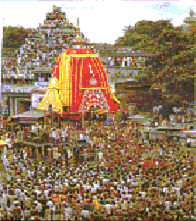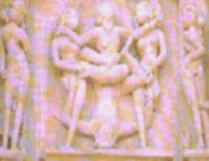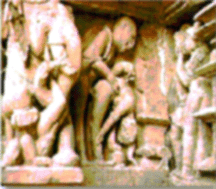Architecture
In India, the establishment of the Muslim power around the 12th century brought in fresh principles and practices in the realm of architecture, which continued for the next 600 years. This Indo-Islamic architecture had three main divisions. They are:
The first, known as the Sultanate or the Imperial phase , refers to the structures raised by the Turkish and the Afghan Rulers who lasted for three and a half centuries. Delhi and its environs occupied the center stage. After the death of Alauddin Khilji in 1316, the central power was very weak and this political independence encouraged the growth of individual trends in architecture. Local ideas and peculiarities were involved and it was called the provincial phase.
Akbar's Fatephur Sikri Fort :

Akbar's Fatephur Sikri Fort
The Akbar's style can be seen in the fortress palace of Agra and Fatehpur sikri, his new capital near Agra. Of the administrative buildings the most distinctive one is the Diwani-I-khas or the Hall of the Private Audience, built in 1575.
Taj :

Taj
The surroundings of the Taj have been restored to the original designs of Ali Mardan Khan , a noble at the court of Shah Jahan. A red stone channel set between rows of Cypress trees accentuates the main vista. The main entrance is from the west, but there are two other entrances, from the east and the west. The main gateway is a large three-storey sandstone structure with an octagonal central chamber with smaller rooms on each side. The walls are inscribed with Quran verses.
The Makrana white marble of the Taj assumes subtle variations of light, tint and tone during different parts of the day. At dawn it assumes a soft dreamy aspect, at noon, it appears to be a dazzling white and in the moonlight, the dome looks like a huge iridescent pearl.
Rock cut Architecture
Hindu and Jain rock-cut architecture can be seen mainly at Badami, Aihole, Ellora, Elephanta, Aurangabad and Mamallapuram.Badami has four cave temples executed at various levels of the sandstone hill.
Cave No 1 is dedicated to Lord Shiva, caves 2 and 3 are dedicated to Lord Vishnu, the Protector and cave 4 is a Jain structure. Aihole has two rock-cut temples, one is of Jain origin and the other one is Brahmanical.
Ellora has 23 cave temples out of which 17 are Brahmanical and the rest six are Jain caves.
Southern Architecture

Five Rathas

Arjuna's Penance
The descent to the earth of the sacred river Ganges is the subject of the most important relief. About 20 feet high and 80 feet long, it contains over a hundred figures of gods, men and beasts. A cistern was provided at the top, which released water on special occasions to add a touch of reality to the tableau. In early 8th century, work begun on the Shore Temple at Mahabalipuram. This temple was built to honor Lord Shiva. The Shore temple was built with granite blocks and it is the earliest known stone-built temple in South India.

Ekambareshvara Temple
The Vardhamana temple is the most important Vaishnava temple in KAnchipuram. One of the two high towered gopuras resemble 12th and 13th century Chola projects while the other is characteristic of the 16th century Vijayanagar period. The main sanctuary enshrines bronze images of Vishnu flanked by his consorts. Some specimens of the Vijayanagara paintings are still preserved on the walls.
Odishan architecture
The temples of Odisha are of the Indo-Aryan style, which is distinct from the South Indian style. The main group of temples is concentrated in the town of Bhubaneshwar. A few miles from this town are the two large buildings in East India, namely, Puri Jagannath Temple and Konark Sun Temple.
Puri Jagannath Temple at Odisha
The grandest achievement of Odishan School of architecture is the Sun Temple at Konark, (1250 A.D) standing some 20 miles form Puri. It is dedicated to Lord Surya, the Sun God, who has been represented as riding his winged chariots drawn by seven horses. The temple is therefore fashioned like a Ratha or Chariot and the base of the structure has 12 giant wheels, each nearly ten feet high. The entire structure is filled with sculpted forms. Today the temple lies abandoned under the care of the Archaelogical Survey of India, unlike the Puri temple, which draws thousands of pilgrims all year round.
Central Indian Architecture

Athletic positions in Khajuraho

Khajuraho sculptures
They are elaborately decorated with sculptures. Other than numerous deities enshrined in the wall niches, there are attendants, maidens in very provocative postures, dancers, musicians, and embracing couples. On one temple alone about 650 figures are depicted. Many of these compositions display great sensuality and warmth. There are also scenes of explicit sexual activities. Sexual postures follow the Kama Sutra, the ancient Indian manual on the art of lovemaking.


